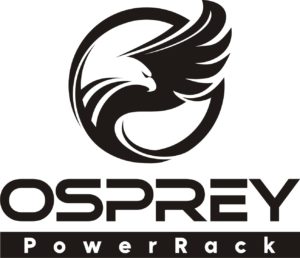Ground-Mount Vs Roof-Mount Solar Racking
Key Takeaways
- Roof-mount solar racking is more affordable and utilizes existing space but may be limited by roof conditions.
- Ground-mount solar racking offers flexibility in placement and can be adjusted for maximum sunlight but typically requires more land and higher installation costs.
- Both systems have pros and cons that should be carefully weighed based on individual needs and property characteristics.
- Nuance Energy’s Osprey PowerRack® technology provides a cost-effective, durable, and easy-to-install ground-mount solar racking solution that significantly reduces installation time and labor costs, making it an ideal choice for both residential and commercial solar projects.
Overview of Solar Mounting Systems
Selecting the right solar mounting system is a key decision that influences multiple aspects of solar energy installation, from performance and efficiency to cost and aesthetic appeal.
Importance of Choosing the Right Mounting System
- Efficiency and Energy Production: The positioning and orientation of your solar panels are critical for maximizing sunlight exposure. A well-chosen mounting system ensures your panels capture the maximum possible sunlight throughout the day, directly influencing the amount of electricity generated and your overall energy savings.
- Cost and Maintenance Considerations: The type of mounting system you choose can significantly impact both the initial installation costs and ongoing maintenance expenses. Certain systems may require more complex installations or specialized labor, driving up costs, while others might simplify maintenance tasks, reducing long-term expenses.
- Aesthetics and Property Value: Solar mounting systems also affect the visual appeal of your property. The system’s design, visibility, and integration with existing structures can either enhance or detract from your property’s aesthetics, which in turn can impact its market value.
| Nuance Energy is your superior solution for Ground Mount solar. Our patented foundation technology, in the Osprey PowerRACK®, allows for rapid installation using only handheld tools, significantly reducing both time and costs compared to traditional racking systems. This cutting-edge technology works for residential and commercial installations, and Nuance Energy empowers solar installers to take back control of their installation schedules, control project COGS, gain market share, increase the speed of install, and reduce costs and labor. In contrast, a traditional ground mount is much more unpredictable, slower, and costly.
Find out how Nuance Energy can accelerate your solar projects with the Osprey PowerRACK® line, and boost your profitability. Contact us today to discuss our innovative ground-mount solutions. |
Types of Solar Mounting Systems
Roof-Mount Systems
Roof-mount systems are the most common type of solar installation, particularly for residential properties. They utilize the existing roof structure to support the solar panels, making them an efficient use of space, especially in urban environments.
- Flush Mount:
- Description: Solar panels are mounted parallel to the roof surface with a small gap to allow airflow. This method is typically used on sloped roofs with good solar orientation.
- Advantages: Flush mounts are cost-effective and minimize wind resistance. They are discreet and blend well with the roofline, making them aesthetically pleasing.
- Disadvantages: Limited flexibility in panel angle adjustment, which can affect energy production if the roof’s orientation is not ideal.
- Tilted Mount:
- Description: Panels are installed at an angle to optimize their orientation for maximum sunlight exposure. This is common on flat roofs or roofs that do not have an optimal slope for solar.
- Advantages: Allows for better energy production by adjusting the tilt to capture more sunlight, particularly in locations with less ideal solar exposure.
- Disadvantages: May be more visible and less aesthetically pleasing than flush mounts. The installation is more complex, potentially increasing costs.
- Ballasted Mount:
- Description: Panels are held in place by weights, such as concrete blocks, instead of being drilled into the roof. This method is mainly used on flat roofs where roof penetration is not preferred.
- Advantages: No roof penetration reduces the risk of leaks and roof damage. It’s also easier to remove or reposition panels if needed.
- Disadvantages: Adds weight to the roof, which could require structural assessment. It may not be suitable for all roof types, particularly those with lower load-bearing capacity.
- Rail-less Mount:
- Description: This system uses brackets directly attached to the roof, eliminating the need for traditional mounting rails.
- Advantages: Reduces material costs and installation time, and is ideal for simple roof designs.
- Disadvantages: Best suited for straightforward installations; complex roof structures may still require rails for proper support.
Advantages of Roof-Mount Systems
- Space Efficiency: Utilizes existing roof space, making it an excellent option for urban areas where ground space is limited.
- Lower Installation Costs: Generally cheaper to install due to reduced infrastructure needs, such as no requirement for additional ground preparation or foundations.
- Protection and Utilization: Roof-mount systems can protect the roof from weathering by providing an additional layer, while also making use of an otherwise underutilized part of the property.
Disadvantages of Roof-Mount Systems
- Limited to Roof Space and Orientation: The system’s efficiency is constrained by the available roof area and its orientation, which may not always be optimal for solar energy production.
- Potential for Roof Damage: Improper installation can lead to leaks or damage to the roof structure, necessitating repairs or reinforcement.
- Maintenance Challenges: Accessing roof-mounted panels for cleaning or repairs can be more difficult and costly, particularly on steep or high roofs.
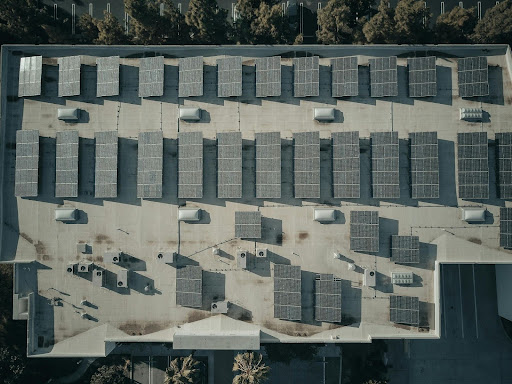
Roof-mounted solar panels utilize existing space on top of a building, capturing sunlight to generate clean energy while integrating with the structure’s design.
Types of Ground-Mount Solar Mounting Systems
Ground-mount systems are ideal for larger installations, often used in commercial, agricultural, or utility-scale projects. These systems offer greater flexibility in placement and orientation compared to roof-mount systems.
- Standard Ground Mount:
- Description: Panels are mounted on a metal or aluminum structure anchored to the ground. The height and angle of the panels can be adjusted for optimal sunlight exposure.
- Advantages: Offers flexibility in positioning and can be placed in areas with maximum sunlight exposure. Easier to access for maintenance.
- Disadvantages: Requires more land, making it less suitable for properties with limited space. Higher installation costs due to the need for additional infrastructure.
- Pole Mount:
- Description: Panels are mounted on poles embedded into the ground, allowing for easy adjustment of panel orientation and tilt.
- Advantages: Elevates panels to avoid shading from nearby objects and can be adjusted to optimize solar exposure.
- Disadvantages: Requires sturdy poles and more complex installation, potentially increasing costs.
- Tracker System:
- Description: Advanced ground-mount systems that track the sun’s movement throughout the day, adjusting the panels’ angle accordingly. Available in single-axis (rotates east to west) or dual-axis (rotates both horizontally and vertically).
- Advantages: Maximizes energy production by maintaining optimal solar exposure throughout the day.
- Disadvantages: More expensive and complex to install and maintain due to the moving parts and additional infrastructure required.
Advantages of Ground-Mount Systems
- Optimal Positioning: Panels can be positioned and angled precisely to capture the maximum amount of sunlight, enhancing energy production.
- Ease of Maintenance: Panels are more accessible for cleaning and maintenance, reducing long-term upkeep costs.
- Scalability: Ground-mount systems are easily scalable, making them ideal for larger installations where more panels can be added as needed.
Disadvantages of Ground-Mount Systems
- Higher Installation Costs: The need for additional infrastructure, such as foundations or anchors, increases the initial cost of installation.
- Land Use: Ground-mount systems require significant land space, which might not be available in all locations, and they can limit the use of the land for other purposes.
- Vandalism and Pests: Being at ground level, these systems are more vulnerable to damage from wildlife, vandalism, or environmental factors.
- Geotechnical Report Requirements: Traditional ground-mount systems often require a geotechnical report to assess soil stability and determine the appropriate foundation design. This process can be time-consuming and costly, involving additional mobilizations to the site, analysis, and delays while waiting for results. The need for a geotechnical report can add unpredictability to the project timeline and costs, especially if the site conditions are found to be challenging.
Recent advancements have produced racking systems that require no geotechnical surveys. This is accomplished through specialized tools that measure soil conditions in real time.
| Factor | Ground-Mount Solar | Roof-Mount Solar |
| Cost per kWh | Generally higher due to additional infrastructure, averaging around $2.80 to $3.70 per watt. | Typically lower, ranging from $2.75 to $3.50 per watt. |
| Productivity | Higher flexibility in orientation and tilt, leading to optimized energy production. | Limited by roof orientation and angle, which might not be optimal for maximum sunlight exposure. |
| Capacity Factor | Potentially higher due to better positioning and less shading. | May be lower if roof orientation and shading are not ideal. |
| Environmental Impact | Occupies more land, potentially affecting land use and ecosystems. | Minimal additional environmental impact since it uses existing structures. |
| Return on Investment (ROI) | Longer payback period due to higher initial costs but can be offset by increased energy production. | Typically faster ROI because of lower initial investment, though less flexible in expansion. |
| Number of Mobilizations | Higher due to the need for land preparation, foundation construction, and more extensive wiring. | Lower, as the existing roof structure reduces the need for additional mobilizations. |
| Installation Time | Longer, often taking 4-8 weeks depending on site preparation and complexity. | Shorter, typically 2-4 weeks depending on roof complexity and permitting. |
| Residential Pricing | $27,000 – $60,000+ before incentives for a 5-15 kW system. | Typically 10-20% cheaper than ground-mounted systems, around $20,000 – $30,000 for similar sizes. |
| Commercial Pricing | $150,000 – $500,000+ before incentives for a 50-200 kW system. | Generally more cost-effective than ground-mount due to the use of existing infrastructure. |
The prices provided are estimates and are accurate as of the time of writing. Actual costs may vary depending on the specific requirements and conditions of each individual project.
Pros and Cons
Pros of Roof-mount Solar Racking
- Space Efficiency: Utilizes existing roof space that is often unused, keeping the yard and other areas open for other uses.
- Lower Installation Costs: Less expensive to install than ground-mounted systems due to simpler infrastructure requirements.
- Reduced Risk of Damage: Panels are less likely to be damaged by pests or vandalism compared to ground-mounted systems.
- Ease of Access: They don’t need extensive writing and are easier to connect to the existing electrical system in the property.
Cons of Roof-mount Solar Racking
- Limited Roof Space: The size and orientation of the roof may limit the number of panels that can be installed.
- Roof Damage: Risk of installation causing damage to the roof or compromising its integrity if not done properly.
- Maintenance Challenges: Cleaning and maintaining the panels is more difficult due to their height and location.
- Shade Issues: Roof-mounted systems are more susceptible to shading from nearby trees or structures.
Pros of Ground-mount Solar Racking
- Optimal Positioning: Allows for better positioning and angling of panels to maximize sunlight exposure and energy production.
- Easier Maintenance: Panels are easier to access for cleaning and maintenance since they are installed at ground level.
- Flexibility: Greater flexibility in panel placement and can be installed in locations with optimal solar exposure.
- No Structural Impact: Unlike roof-top systems, ground-mount panels don’t affect the integrity of your property or add weight to it.
- Scalability: Easier to expand the system if you want to add more panels in the future.
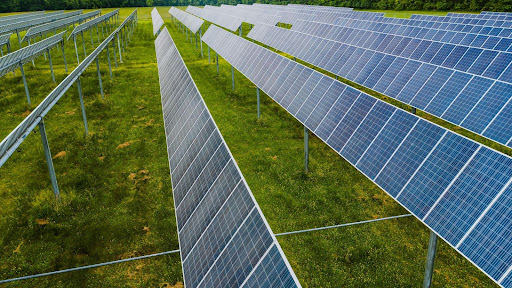
Standard ground mounts provide a stable and efficient foundation for solar panels in open fields, optimizing energy production through flexible placement and tilt options.
Cons of ground-mount Solar Racking
- Higher Installation Costs: More expensive to install due to the need for additional infrastructure and land preparation.
- Space Requirement: Requires a significant amount of land, which makes them impractical for properties with limited space.
- Vandalism and Pests: More exposed to potential damage from animals, vandalism, or other environmental factors.
- Permitting and Regulations: May face more complex permitting requirements and local regulations for installation compared to roof-mounted systems.
Impact of Shading and Orientation
Roof-mounted systems can be more susceptible to shading from nearby trees, buildings, or other obstructions – which can significantly reduce the energy output of the panels.
Ground-mount systems, on the other hand, offer more flexibility in placement. You can position them in areas with minimal shading and adjust the tilt and orientation to maximize sunlight exposure and increase energy production.
Weather Considerations and Durability
Roof-mounted systems are more exposed to the elements, which can lead to wear and tear over time. High winds, heavy snowfall, and extreme temperatures can all impact the durability of roof-mounted panels.
That’s not an issue with ground-mounted systems, which are built to withstand harsher weather conditions. They can be anchored more securely into the ground, making them more resilient to strong winds and heavy snow loads. Additionally, ground-mounted panels are easier to clear of snow and debris, ensuring consistent energy production.
Installation Considerations
- Available Space: Roof-mount systems are ideal for properties with limited land but sufficient roof space. Meanwhile, ground mounts require more land but offer greater flexibility in placement.
- Roof Condition: The structural integrity of your roof is a significant consideration. Roof mounts may necessitate roof repairs or upgrades, adding to the overall cost.
- Sunlight Exposure: Evaluate the shading and orientation of both potential locations to determine which option will maximize energy production.
- Local Regulations: Check local building codes and zoning laws, as they may have specific requirements for solar installations.
Permitting Processes and Requirements
- Roof-mount Systems: Permitting for roof-mounted systems is fairly simple – you will need to provide structural calculations to ensure your roof can support the additional weight of the panels.
- Ground-mount Systems: You may need to conduct geotechnical surveys and obtain zoning approvals, especially if the installation is large or in a residential area, which makes permitting a bit more challenging.
Cost Factors and Return on Investment
As mentioned earlier, roof-mount systems are generally more cost-effective to install because they use existing structures. However, while ground racking tends to be pricier, its flexibility in placement can lead to increased energy production, so it might actually be offering a better return on investment over time.
Aesthetic and Environmental Impact
Visual Impact
Roof-mount systems are less obtrusive and a better choice for homeowners who want to maintain the aesthetic appeal of their property while harnessing solar energy.
Ground mounts offer greater flexibility in placement, but they may require careful planning to minimize their visual impact on your property – and for smaller lots it’s not going to be easy to tuck away the panels in a spot where they don’t stand out.
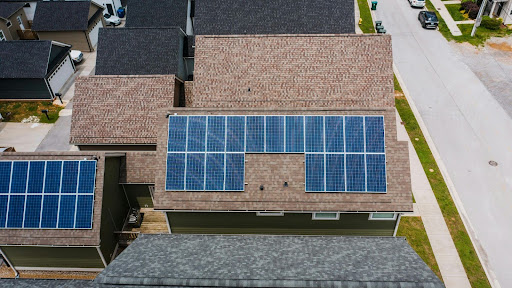
Roof-mount systems have the advantage of blending seamlessly into the property’s aesthetics.
Noise and Wildlife Considerations
Both ground-mount and roof-mount systems operate quietly, making them suitable for residential installations. However, ground-mount systems can sometimes impact local wildlife, particularly if they are installed in rural or undeveloped areas.
Maintenance and Accessibility
Ease of Access
Ground-mount systems allow for straightforward cleaning, inspection, and replacement of components due to their location.
Roof-mount systems, on the other hand, can be more challenging to maintain due to their elevated position. Accessing roof-mounted panels often requires specialized equipment and safety measures, which can increase maintenance costs.

Ease of access is an important consideration when considering the type of solar racking.
Maintaining Solar Racking Systems
Maintaining ground-mount solar racking systems comes with its own set of challenges:
- Vegetation Growth: Regular trimming of grass and vegetation around the panels is necessary to prevent shading and maintain optimal performance.
- Soil Erosion: Ground-mounted systems may require additional measures to prevent soil erosion, particularly in areas with heavy rainfall.
Roof-mount systems pose their own issues:
- Roof Integrity: Ensuring the roof remains in good condition is essential to prevent leaks and structural damage.
- Weather Damage: Roof-mounted panels are more exposed to the elements and need regular inspections for weather-related damage.
Solar Racking Structures by Nuance Energy
Nuance Energy offers innovative mounting solutions not available from other industry players.
We are the developers behind the Osprey PowerRACK®, a proprietary solar racking system providing flexibility and ease of installation for ground-mount solar systems.
The Osprey PowerRACK®
The Osprey PowerRACK® is a versatile solar racking solution that can be used for ground-mount installations. It is designed to be easy to install, requiring minimal tools and just two to three technicians.
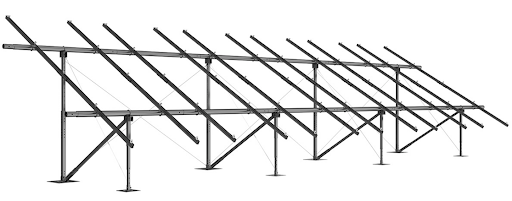
The pre-engineered Osprey PowerRACK® is an easy-to-install, durable alternative to traditional ground-mount systems.
Benefits of Using the Osprey PowerRACK®
- Ease of Installation: The Osprey PowerRack® is engineered for swift and straightforward installation, allowing a small crew to complete the setup in just a few days. This rapid deployment capability is especially beneficial for residential installations, where reducing labor time translates into significant cost savings. Unlike traditional systems that require heavy machinery, the Osprey PowerRack® can be installed using only hand held tools, further simplifying the process and making it accessible to a broader range of installers.
- Durability: Constructed with high-quality materials, the Osprey PowerRack® is built to endure harsh weather conditions, ensuring long-term reliability. Its robust design makes it suitable for a wide range of environments, from rural agricultural settings to industrial sites, where consistent performance over time is crucial.
- Flexibility: The Osprey PowerRack® offers exceptional flexibility, allowing for the adjustment of panel orientation to optimize sunlight capture and maximize energy production. This adaptability is vital in scenarios where terrain and sunlight conditions vary, ensuring that each installation achieves its full potential.
- Earth Anchor Foundation Technology: A standout feature of the Osprey PowerRack® is its patented earth anchor foundation technology. This innovative approach eliminates the need for concrete foundations, making the system lighter, easier to install, and more environmentally friendly. The earth anchors provide a secure foundation, even in soft or variable soil conditions, ensuring stability without the complications of traditional foundation methods.
- Time and Cost Savings: The system is designed to reduce both the time and cost associated with solar installations. By minimizing the number of required mobilizations to the site and simplifying the installation process, the Osprey PowerRack® allows for quicker project turnaround. Additionally, the system’s design enables the use of a less specialized labor force, further driving down costs and making solar installations more accessible and cost-effective.
- No Need for Geotechnical Reports: One of the significant advantages of the Osprey PowerRack® is that it eliminates the need for geotechnical reports. Traditional solar racking systems often require extensive soil analysis and the design of foundations based on these reports, which can be time-consuming and expensive. The Osprey PowerRack® is installed using real-time soil conditions, providing immediate load testing results that are more accurate and often preferred by local authorities.
- Predictable Project Costs and Installation Time: The Osprey PowerRack® technology ensures predictable project costs by removing the uncertainty and delays associated with geotechnical surveys and traditional foundation designs. This predictability is crucial for large-scale projects where budget adherence and timeline are paramount.
- Scalability: The modular design of the Osprey PowerRack® makes it scalable and adaptable to various project sizes, from small residential arrays to large commercial installations. Its ability to accommodate different terrain types and soil conditions without extensive ground preparation makes it a versatile solution for diverse applications.
- Environmental and Cost Benefits: By avoiding the use of concrete and employing minimally invasive earth anchors, the Osprey PowerRack® significantly reduces the environmental impact of solar installations. This is particularly advantageous in ecologically sensitive areas or where land restoration is a priority. The reduction in materials, labor, and equipment costs also makes the system highly cost-efficient, offering competitive advantages in the solar market.
Use Cases
- Commercial and Industrial Projects: The system’s scalability and adaptability make it ideal for large-scale commercial and industrial installations.
- Agricultural and Rural Installations: The lack of need for concrete foundations makes the system particularly suited for agricultural lands and rural areas.
- Temporary or Semi-Permanent Installations: Its non-permanent anchoring system allows for quick deployment in temporary or semi-permanent setups, such as in disaster relief or temporary power situations.

Nuance Energy primarily deals with solar installers.
Frequently Asked Questions (FAQ)
What factors should I consider when choosing between ground and roof-mount solar racking?
When choosing between ground and roof-mount solar racking, consider the space available on your property, local regulations, the amount of sunlight your location receives, and the costs associated with the racking system and its installation.
Are there any significant cost differences between ground and roof-mount installations?
Roof-mount systems are generally more cost-effective to install because they utilize existing structures. Ground-mount systems tend to be pricier initially due to the need for additional materials, such as mounting structures and foundations – but can be much more efficient with our unique Osprey PowerRack®.
Which type of mounting system is better for areas with heavy snow or strong winds?
In areas with heavy snow or strong winds, ground-mount systems are often the better choice. They can be anchored more securely into the ground, making them more resilient to strong winds and heavy snow loads.
What are the maintenance considerations for each system?
Ground-mount systems are easier to access for cleaning and maintenance, while roof-mount systems can be more challenging to reach, especially on steep roofs.
How do aesthetics play a role in choosing between the two?
Roof-mounted systems are less intrusive and often considered more aesthetically pleasing, as they are installed out of sight. Ground mounts can take up valuable yard space and may not blend well with local landscaping.
Save Time & Money on Your Next Solar Project
Request a QuoteRECENT POSTS
- DPW Solar vs Nuance Energy Mounted Solar Options: Cost & Benefits
- Geotechnical Report Cost & Requirements For Solar Projects
- Are Solar Panels Worth It In Nevada? Costs & Options
- OSPREY PowerRack Ground Mount System Compatibility: Single- and Dual-Axis Trackers
- Rammed Earth Foundation For Solar Arrays: Cost, Pros & Cons
- Agrivoltaics Explained: Solar & Agriculture Combined
- Large Scale Solar Systems Options: Pros & Cons
- Best Solar Options For Farms & Agriculture: Cost, Pros & Cons
- Unirac vs MT Solar Mounted Options: Cost & Benefits
- IronRidge vs Grengy Mounted Solar Options: Cost & Benefits

